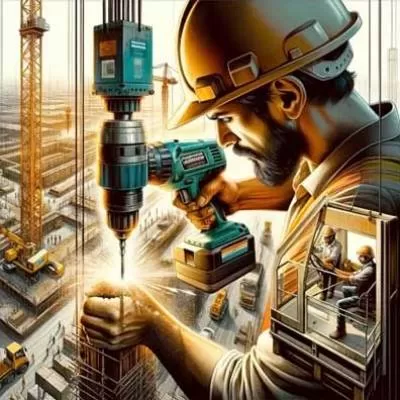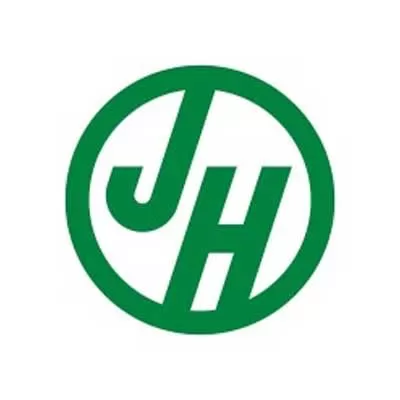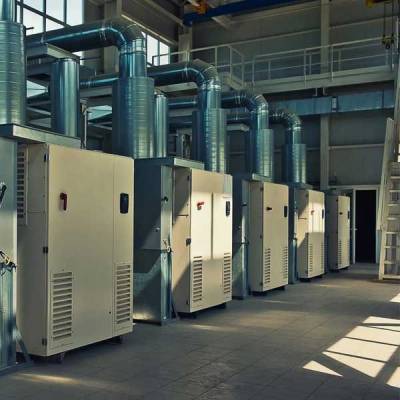- Home
- Real Estate
- Safety Does Not Happen By Accidents
Safety Does Not Happen By Accidents
In India, the construction sector accounts for around 7.9 per cent of the country's GDP. It is the second largest employer and contributor to the economy, after agriculture, and most often than not relies on unorganised labour. This also poses a huge challenge when it comes to safety at the workplace.
In my last series, I analysed the identification of hazards that may cause injury, assessment of risks associated with these hazards as well as appropriate risk control measures. Click here to read: https://bit.ly/3azZ7ri
This article focuses on different methodologies and aids available for implementing risk control measures. As already mentioned in the first part, before working at a height, one must work through these simple steps:
• Avoid work at height where it is reasonably practicable to do so;
• Where work at height cannot be avoided, prevent falls using either an existing place of work that is already safe or the right type of equipment;
• Minimise the distance and consequences of a fall, by using the right type of equipment where the risk cannot be eliminated.
Any equipment that is specifically designed to allow the user to work safely at height (eg: ladders, scaffolds, tower scaffolds) is commonly called ‘access equipment’.
Considering the risks associated with work at height and putting in place sensible and proportionate measures to manage them is an important part of working safely.
Fourth: Implementing Risk Control Measures
Guard Railing
• Requirements include:
o Top rail, Mid rail and toe boards above the platform (work surface)
o Toe boards shall be of minimum height of 100 mm, while mid rail and top rail shall be at height of around 600 mm and around 1100 mm respectively.
• If access is required to equipment (e.g. a hoist) it should be protected with gates, safety chains or other means to prevent a person falling.
Scaffolds
• Have scaffolding erected and dismantled without exposure to risk of falling by competent people.
• Scaffolding is to include complete floors, two railings, a kick plate and a valid Scaffolding tag.
• A safe access and egress shall be provided.
• The scaffold and its supporting structure must be inspected by a Scaffolding Inspector /competent person before use, after any incident that could affect its stability (such as a severe storm), after any repairs, and at least every week.
• Attach safety harnesses to an anchored lanyard whilst erecting, dismantling or working from a scaffold when required.
• Display relevant information at each entry point of the scaffold.
o Relevant information to be displayed includes:
• Whether the scaffold is complete and safe to use
• The load capacity of the work platforms
• The record of regular inspection completed by a competent person.
• Regular inspection of the scaffold is required to assure its continued structural integrity.
Mobile safe tower
Where mobile safe tower is used to perform work, workers should be trained to ensure that:
• Top rail, mid rail and toe guard are provided
• It remains level and plumb at all times
• Is kept well clear of power lines, open floor edges and penetrations
• Is not accessed until the castors are locked to prevent movement
• Is never moved while anyone is on it
• Is only accessed using internal ladders
Elevating Work Platforms
• Elevating Work Platforms (EWPs) include scissor lifts, cherry pickers, boom lifts and travel towers. There are battery powered and internal combustion engine types. Some are designed for hard flat surfaces only, while others are designed to be operated on rough terrain.
• Workers operating the platform are trained and instructed in safe operating procedures for the particular brand and type of equipment, as well as the safe use of fall-arrest equipment and emergency rescue procedures
• The manufacturer’s or supplier’s instructions are consulted for information on safe operation
• Persons working in travel towers, boom lifts or cherry pickers wear a properly anchored safety harness
Man basket
• A Man basket may only be used only where it is not reasonably practicable to use a preferred working platform such as an Elevated working platform or scaffold.
Ladders
• Portable ladders shall only be used for access and not for executing work. All ladders shall be included in the ladder inspection program. Ladder safe tag is available on ladder.
Working on Trucks/ Tankers
• Use approved methods to climb on and off the back of trucks.
o For example, access ladders or platforms, maintaining three points of contact.
o Wear hard hats with chin straps while working on the back of trucks
• While working on the top of trucks
o Wear hard hats with chin straps while working on the back of trucks
o Wear harness and have karabiners locked with fall arrestors placed in lifelines.
Fall Arrest Systems
• A fall-arrest system is intended to safely stop a worker falling an uncontrolled distance and reduce the impact of the fall.
• Only use fall arrest systems when higher control measures in the Hierarchy of Controls are not practical such as fall restraint.
• Only use approved equipment and combinations of equipment.
• Fall-arrest systems, incorporating a lanyard, must be installed so that the maximum distance a person would free fall before the fall-arrest system takes effect is less than 2 metres.
• There should be sufficient distance between the work surface and any surface below to enable the system, including the action of any shock absorber to fully deploy
• There should be a minimum of slack in the fall-arrest lanyard between the user and the attachment. The anchorage point should be as high as the equipment permits. Avoid work above the anchor point, as this will increase the free fall distance in the event of a fall, resulting in higher forces on the body and greater likelihood of the lanyard snagging on obstructions.
Fall Clearance
The adequate distance for a person or persons who are using a fall arrest system so that in the event of a fall the user of the system will not strike the ground, floor or any other obstacle, item or thing beneath the system. This comprises the Length of lanyard + Tear-out (Break) distance + height of user + safety margin.
• Workers using a fall-arrest system wear adequate head protection to protect them in the event of a fall.
• Have a Standby Person when personnel are using fall arrest systems. Employees shall not work alone.
• Develop recovery or rescue plan that allows for the rescue of fallen people.
When selecting equipment for work at height, we must:
• Provide the most suitable equipment appropriate for the work
• Take account of factors such as:
o The working conditions (eg weather);
o The nature, frequency and duration of the work;
o The risks to the safety of everyone where the work equipment will be used.
If you are still unsure what type of equipment to use, please consult an expert who is knowledgeable and experienced in this field for advice.
In the next part of this article, we will cover some more aspects which must be reviewed prior to working at height is undertaken. In the meantime, follow these tips and work safely at height.
In India, the construction sector accounts for around 7.9 per cent of the country's GDP. It is the second largest employer and contributor to the economy, after agriculture, and most often than not relies on unorganised labour. This also poses a huge challenge when it comes to safety at the workplace. In my last series, I analysed the identification of hazards that may cause injury, assessment of risks associated with these hazards as well as appropriate risk control measures. Click here to read: https://bit.ly/3azZ7riThis article focuses on different methodologies and aids available for implementing risk control measures. As already mentioned in the first part, before working at a height, one must work through these simple steps:• Avoid work at height where it is reasonably practicable to do so;• Where work at height cannot be avoided, prevent falls using either an existing place of work that is already safe or the right type of equipment;• Minimise the distance and consequences of a fall, by using the right type of equipment where the risk cannot be eliminated.Any equipment that is specifically designed to allow the user to work safely at height (eg: ladders, scaffolds, tower scaffolds) is commonly called ‘access equipment’.Considering the risks associated with work at height and putting in place sensible and proportionate measures to manage them is an important part of working safely.Fourth: Implementing Risk Control MeasuresGuard Railing• Requirements include:o Top rail, Mid rail and toe boards above the platform (work surface)o Toe boards shall be of minimum height of 100 mm, while mid rail and top rail shall be at height of around 600 mm and around 1100 mm respectively.• If access is required to equipment (e.g. a hoist) it should be protected with gates, safety chains or other means to prevent a person falling.Scaffolds• Have scaffolding erected and dismantled without exposure to risk of falling by competent people.• Scaffolding is to include complete floors, two railings, a kick plate and a valid Scaffolding tag.• A safe access and egress shall be provided.• The scaffold and its supporting structure must be inspected by a Scaffolding Inspector /competent person before use, after any incident that could affect its stability (such as a severe storm), after any repairs, and at least every week.• Attach safety harnesses to an anchored lanyard whilst erecting, dismantling or working from a scaffold when required.• Display relevant information at each entry point of the scaffold.o Relevant information to be displayed includes:• Whether the scaffold is complete and safe to use• The load capacity of the work platforms• The record of regular inspection completed by a competent person.• Regular inspection of the scaffold is required to assure its continued structural integrity.Mobile safe towerWhere mobile safe tower is used to perform work, workers should be trained to ensure that:• Top rail, mid rail and toe guard are provided• It remains level and plumb at all times• Is kept well clear of power lines, open floor edges and penetrations• Is not accessed until the castors are locked to prevent movement• Is never moved while anyone is on it• Is only accessed using internal laddersElevating Work Platforms• Elevating Work Platforms (EWPs) include scissor lifts, cherry pickers, boom lifts and travel towers. There are battery powered and internal combustion engine types. Some are designed for hard flat surfaces only, while others are designed to be operated on rough terrain.• Workers operating the platform are trained and instructed in safe operating procedures for the particular brand and type of equipment, as well as the safe use of fall-arrest equipment and emergency rescue procedures• The manufacturer’s or supplier’s instructions are consulted for information on safe operation• Persons working in travel towers, boom lifts or cherry pickers wear a properly anchored safety harnessMan basket• A Man basket may only be used only where it is not reasonably practicable to use a preferred working platform such as an Elevated working platform or scaffold.Ladders• Portable ladders shall only be used for access and not for executing work. All ladders shall be included in the ladder inspection program. Ladder safe tag is available on ladder.Working on Trucks/ Tankers• Use approved methods to climb on and off the back of trucks.o For example, access ladders or platforms, maintaining three points of contact.o Wear hard hats with chin straps while working on the back of trucks• While working on the top of truckso Wear hard hats with chin straps while working on the back of truckso Wear harness and have karabiners locked with fall arrestors placed in lifelines.Fall Arrest Systems• A fall-arrest system is intended to safely stop a worker falling an uncontrolled distance and reduce the impact of the fall.• Only use fall arrest systems when higher control measures in the Hierarchy of Controls are not practical such as fall restraint.• Only use approved equipment and combinations of equipment.• Fall-arrest systems, incorporating a lanyard, must be installed so that the maximum distance a person would free fall before the fall-arrest system takes effect is less than 2 metres.• There should be sufficient distance between the work surface and any surface below to enable the system, including the action of any shock absorber to fully deploy• There should be a minimum of slack in the fall-arrest lanyard between the user and the attachment. The anchorage point should be as high as the equipment permits. Avoid work above the anchor point, as this will increase the free fall distance in the event of a fall, resulting in higher forces on the body and greater likelihood of the lanyard snagging on obstructions.Fall ClearanceThe adequate distance for a person or persons who are using a fall arrest system so that in the event of a fall the user of the system will not strike the ground, floor or any other obstacle, item or thing beneath the system. This comprises the Length of lanyard + Tear-out (Break) distance + height of user + safety margin.• Workers using a fall-arrest system wear adequate head protection to protect them in the event of a fall.• Have a Standby Person when personnel are using fall arrest systems. Employees shall not work alone.• Develop recovery or rescue plan that allows for the rescue of fallen people.When selecting equipment for work at height, we must:• Provide the most suitable equipment appropriate for the work • Take account of factors such as:o The working conditions (eg weather);o The nature, frequency and duration of the work;o The risks to the safety of everyone where the work equipment will be used.If you are still unsure what type of equipment to use, please consult an expert who is knowledgeable and experienced in this field for advice.In the next part of this article, we will cover some more aspects which must be reviewed prior to working at height is undertaken. In the meantime, follow these tips and work safely at height.
























